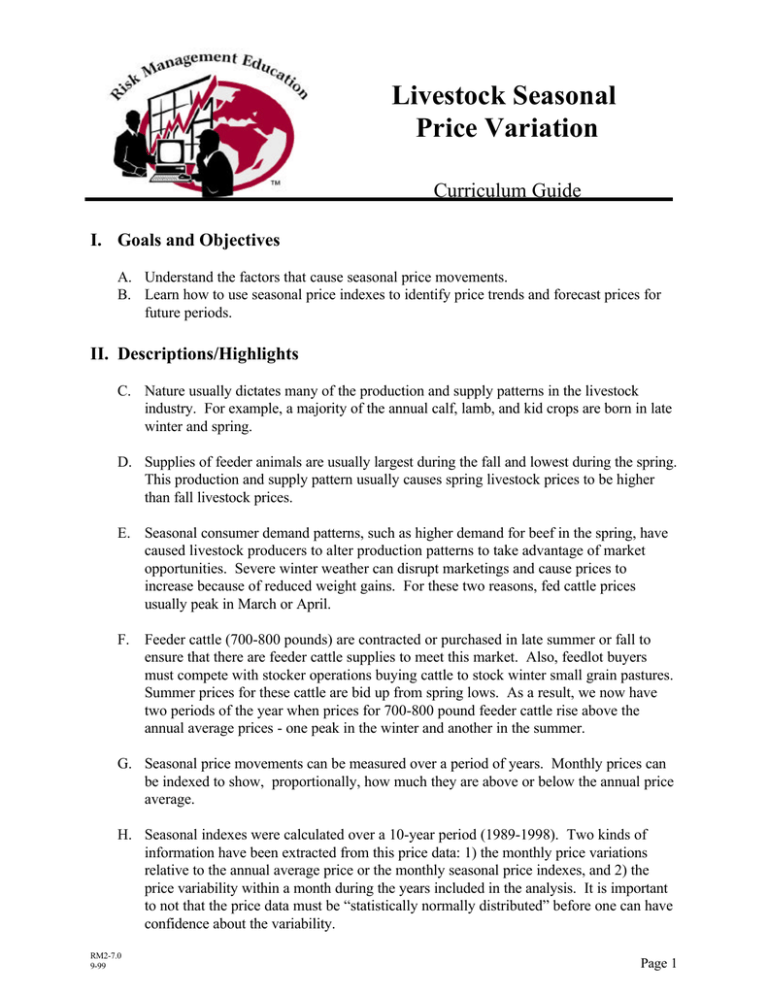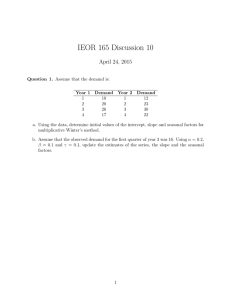Livestock Seasonal Price Variation Curriculum Guide
advertisement

Livestock Seasonal Price Variation Curriculum Guide I. Goals and Objectives A. Understand the factors that cause seasonal price movements. B. Learn how to use seasonal price indexes to identify price trends and forecast prices for future periods. II. Descriptions/Highlights C. Nature usually dictates many of the production and supply patterns in the livestock industry. For example, a majority of the annual calf, lamb, and kid crops are born in late winter and spring. D. Supplies of feeder animals are usually largest during the fall and lowest during the spring. This production and supply pattern usually causes spring livestock prices to be higher than fall livestock prices. E. Seasonal consumer demand patterns, such as higher demand for beef in the spring, have caused livestock producers to alter production patterns to take advantage of market opportunities. Severe winter weather can disrupt marketings and cause prices to increase because of reduced weight gains. For these two reasons, fed cattle prices usually peak in March or April. F. Feeder cattle (700-800 pounds) are contracted or purchased in late summer or fall to ensure that there are feeder cattle supplies to meet this market. Also, feedlot buyers must compete with stocker operations buying cattle to stock winter small grain pastures. Summer prices for these cattle are bid up from spring lows. As a result, we now have two periods of the year when prices for 700-800 pound feeder cattle rise above the annual average prices - one peak in the winter and another in the summer. G. Seasonal price movements can be measured over a period of years. Monthly prices can be indexed to show, proportionally, how much they are above or below the annual price average. H. Seasonal indexes were calculated over a 10-year period (1989-1998). Two kinds of information have been extracted from this price data: 1) the monthly price variations relative to the annual average price or the monthly seasonal price indexes, and 2) the price variability within a month during the years included in the analysis. It is important to not that the price data must be “statistically normally distributed” before one can have confidence about the variability. RM2-7.0 9-99 Page 1 I. Figures 1 -6 plot the average annual price and monthly price index, with the variability range indicated by points above and below the index values. The monthly price index numbers and the monthly variability factors are listed at the bottom of each figure. J. Monthly price indexes can be used as an indication of possible price trends for a period of time. The variability factor can be used to estimate the possibility of prices varying withing the estimated range. Only the price series for Amarillo direct fed steers and San Angelo feeder lambs, 55-90 pounds, are normally distributed. For the other price series’, only seasonal price trends will be useful when planning marketings. K. Seasonal price indexes also can be used to forecast prices for the months ahead based on the past relationship. L. Review Figures 1- 6. III. Potential Speakers A. Extension Economist B. Marketing Advisor IV. Review Questions A. How can seasonal price indexes be used? Answer: The two primary uses of seasonal price indexes are : 1) indications of possible price trends for a period of time, and 2) forecast prices for the months ahead based on past relationships. When developing a marketing plan, this information can be helpful when establishing a target price (sales or purchase), deciding which hedging strategy to use, and in estimating costs and revenues for your projected budget (whole-farm and enterprise budgets). V. For More Details None available at this time. RM2-7.0 9-99 Page 2 Livestock Seasonal Price Variation Ž Livestock Price Seasonality L Majority of annual calf, lamb, and kid crops are born in late winter and spring L Typically, supplies are largest during fall and lowest during spring L Seasonal consumer demands L Severe winter weather can disrupt L Fed cattle prices usually peak in March or April L Feeder cattle (700-800 lbs.) are usually purchased in late summer or fall L Feedlot buyers compete with stocker operations for these cattle L As a result, summer prices are bid up from spring lows L 700-800 lb. feeder cattle prices rise above the annual average price twice a year – winter, summer RM2-7.0 9-99 Page 1 Livestock Seasonal Price Variation Ž Measuring Seasonal Price Movements L Identify seasonal trends L Forecasts prices for future periods L Figures 1 - 5 overview L Price index L Variability factor RM2-7.0 9-99 Page 2 Livestock Seasonal Price Variation RM2-7.0 9-99 Page 3 Livestock Seasonal Price Variation RM2-7.0 9-99 Page 4 Livestock Seasonal Price Variation RM2-7.0 9-99 Page 5







